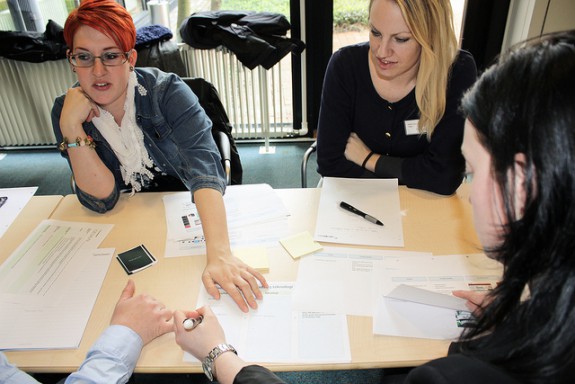Website Workshop: Conduct Successful Workshops In 5 Steps

Clients need to attend a workshop before handing over the project requirements to a web designing company. Yes, that’s right. You might think it is odd for a client to attend a workshop before assigning a project. Probably, that’s because our idea of holding workshops may be conditioned by what we have seen so far.
Clients come looking for a way to come up with the best website that would define their business goals. Some people know that attending a project would solve most of the problems for them, and there are some who don’t know anything about holding or attending a workshop.
In this article, we will be detailing the importance of having website workshops, and how, as a company, you can convince the client in 5 easy steps.
1.Explaining the need for having a workshop
Websites are brand identities, so they must be perfect, communicative and receptive to user requirements. A number of people are involved in a project – from web designers to developers, writers and marketers. To make sure that everyone is on the same page regarding the project, it is important that you hold a workshop.
The client might feel that it is a waste of time, especially since he has made his point clear “I need a website that draws SEO”. But it is important for the agency to have all the information upfront, that’s how all the doubts are cleared, and work proceeds without a hitch. You cannot have someone, perhaps a stakeholder arrive in the middle of the project, and throw a wrench in the works. You can easily flush out problems and nasty surprises right in the beginning itself through a workshop.
If you explain the importance of website workshops there is no doubt that your clients will love them. They can see it as a platform to express their ideas, to engage themselves in the project. They will feel that the resulting website is part of their effort too. As they are involved in the creation process, there are minimal chances that they would reject it too.
2. Collaborate on design and content
Unless there is proper collaboration with the client on the design and content process, there is no doubt that you will have to keep doing a number of iterations till the final product is out. It is not that the client will interfere in the design process, or that they do not trust the judgment of the people they hire.
Clients are always wary of what lies aside, they may or may not have knowledge in design or graphics, and they always hate to part with their check so easily. It is their way of showing they have control over the end product.
The answer lies not in excluding them or resisting them, but having them over for a workshop where you can collaborate with them on what needs to be placed where.
They need the best results for their website, because any mistake and they will not be able to erase it for years. The agencies responsible for developing the website may walk away, and salvage some of their reputation but it is the client who will always have to face the consequences. So this is the step where you educate them on the design process and allay any fears that they have.
If you collaborate with them, they will turn from being a critic to an advocate. They will have their own set of questions to ask, and you will have yours. Go through each and make sure everyone is clear.
3) A whiteboard to draw a mockup
Whiteboards can be customised to create a collaborative effort on how the website will be created. It helps you to understand your client better, what his requirements are, and even a mockup of how the end product will look like.
A workflow of the website will be created, wherein the client can specify his requirements, and what his expectations are. This would be a collaborative session where every team member will make an appearance and understand the challenges of the project.
The whiteboard can start with identification of a problem, presumably, by saying that the company wants to increase its sale. They will go into the ideation process where they will decide on the different ways in which having a website would help with this.
4) Explaining the different approaches, features etc.
By explaining the details in a workshop, it is possible to show the client the different approaches and technologies to use build websites and web applications like WordPress, TYPO3, Contao, Drupal, PHP, ASP.NET, Laravel, Symfony, Zend, etc.
In certain cases, the client would require the simple performance of WordPress, and sometimes, the complicated development process involved in Laravel where authentication, routing, sessions and caching are required.
So this is the stage where you go through the client requirement in detail and select the best under the circumstances.
It is also at this stage where you explain the importance of having Landing Pages, Banners, Images and Videos in the website. Each of these features increase conversions when done correctly. However, it is also crucial that you explain about incorporating only the most important functionalities because you need to develop a website that attracts people and generate sales, not a platform to showcase gimmicks.
5) Define the action plan
Once the content and design is decided, and a workflow is created, you decide on the different approach to take, the technology to use, and the functionalities that must be present in the first version of the website.
Tally your business goals with the above-mentioned steps, and create an action plan on the milestones and deadline (when the website should go live). This action plan will bring you a better direction on how to move forward with the project.
Conclusion
These 5 simple steps would help you collaborate with your clients on the best way to develop their website. Workshops help you create better websites.
The idea is to bring the client into the project, and have their participation, so they don’t feel alienated. Good website doesn’t just happen in the web designer’s mind, it is based on user requirement, brand info and business goals.
Interesting Articles:
How to plan a successful workshop
How to organize a workshop and make it successful
Picture Source: Flickr.com/ PowerMax Energy/ Innovation Lab


